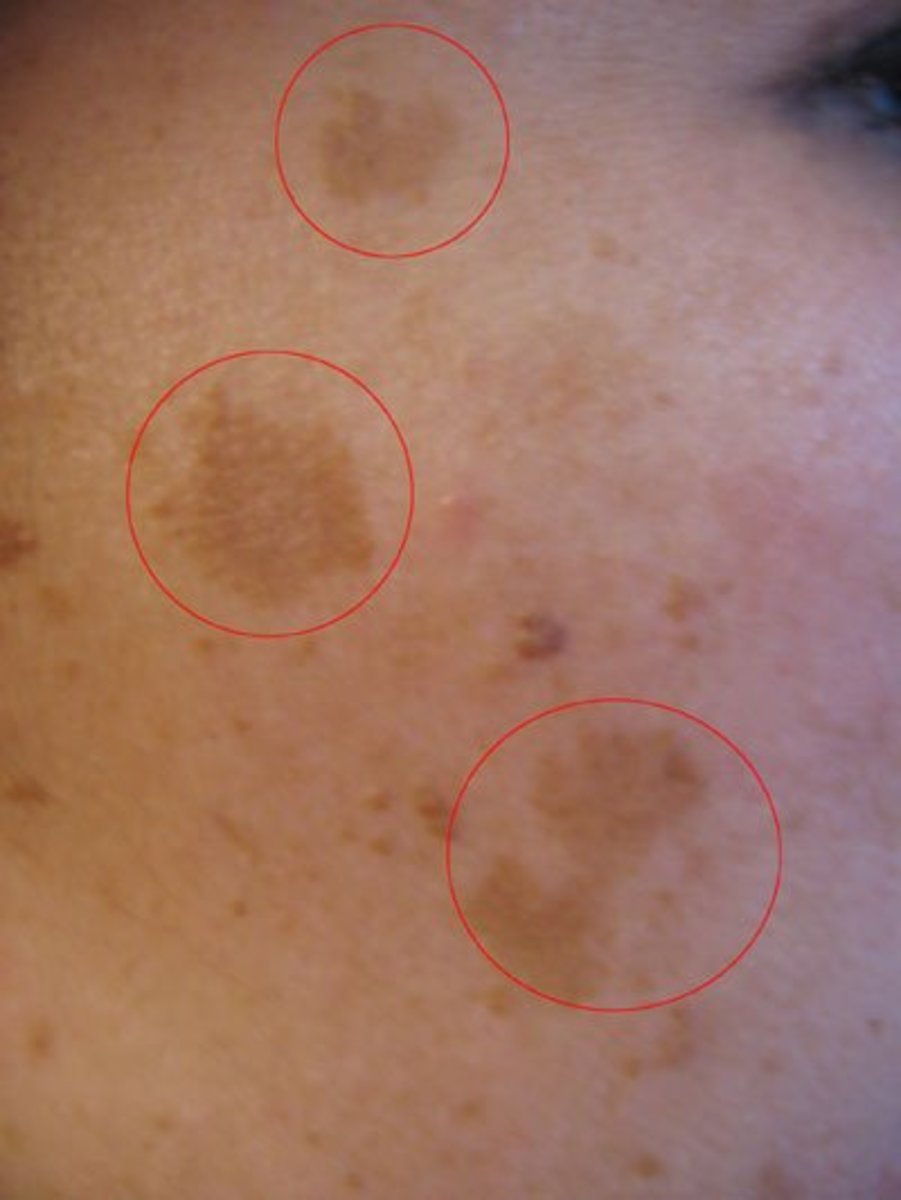
Melasma: Dark Spots on Face
Many adults suffer from melasma: a form of hyperpigmentation in which areas of skin become darker than their surroundings. The dark patches result from an overproduction of melanin from pigment cells called melanocytes. While melasma won't affect your overall health, its characteristic dark spots can often look unsightly, causing distress in those who have it.
Read on to discover some effective ways to eliminate those blemishes and make them less noticeable. This hub will also tell you about what causes melasma so that you can prevent it from developing in the first place.
What is Melasma?
There are a number of possible causes of hyperpigmentation, some of which can be quite serious. So it's best to consult with a doctor if you notice any skin discoloration.
One of the more common forms of hyperpigmentation is melasma, which is characterized by unsightly dark spots on the forehead, cheek, and area above the upper-lip. These spots typically appear on both sides of the face in a similar shape and pattern and can range in color from tan to dark brown.

Tips to Make Melasma Less Noticeable
Even the most aggressive treatment options can take some time to work. In the meantime, there are a lot of things you can do to minimize the appearance of those dark patches. Check out the video below from the American Academy of Dermatology for some great tips and tricks!
Home Remedies for Melasma and Hyperpigmentation
While there are a number of medical procedures to treat melasma, you may want to try some of these home remedies first, especially if you notice the discoloration in its beginning stages.
1. Exfoliation

If the dark patches are new, they may only cover the first few layers of skin. In that case, manually exfoliating the area could be a solution. Find an exfoliating cleanser of your choice and apply it to the area in a circular motion. Repeat once or twice a day for best results.
2. Citrus Rub

Citrus fruits contain a significant amount of ascorbic acid, which can remove the top layer of skin without damage. Squeeze the lemon juice onto a cotton ball, dab it on your skin and leave it on for 20 minutes. Repeat once or twice a day for best results.
Another alternative would be to make a honey and lemon face mask. Mix the juice of half a lemon with two teaspoons of honey. Apply to the affected area for 30 minutes and then wash well.
A final citrus option would be to make a paste of lemon juice with turmeric, which is also a skin-lightening agent. Add one tablespoon of lemon juice to one tablespoon of turmeric, apply to the face for 15 minutes, and wash with warm water.
3. Vitamin E

Vitamin E is a powerful antioxidant and can help your body repair damaged cells. You can apply Vitamin E oil directly to the skin and/or eat foods high in Vitamin E, such as nuts, avocado, leafy greens, tofu, and squash.
4. Papaya

Papaya contains papain, an enzyme that helps exfoliate the skin. Papaya also contains large amounts of Vitamins C and E, which makes it ideal for treating discoloration. Try applying a small piece of the fruit to the affected area twice a day for 20-30 minutes. Or, blend the papaya into a paste for a face mask and apply for 30 minutes.
5. Folic Acid

There have been a number of studies linking melasma to a deficiency of folic acid, and folic acid is frequently prescribed by obstetricians to pregnant women with melasma. So, it's highly recommended to take supplements and eat foods that contain a lot of that key nutrients. Such foods include green, leafy vegetables, citrus fruits, beans, and whole grains.
Medical Treatment Options for Melasma and Hyperpigmentation
Skin treatments have made enormous strides in recent years. There are many good procedures available to cure hyperpigmentation. Below are some of the most popular procedures.
- Discontinue Hormonal Contraception. Since melasma is usually caused by changing levels of estrogen and/or progesterone, discontinuing hormonal contraceptive pills and IUDs can often be a good first step.
- Topical Bleaching Creams. The first line of treatment is usually a topical acid treatment designed to remove the discolored layers of skin. You can find over the counter versions of these treatments and stronger prescription strength ones as well. These creams typically include hydroxy acids. If you want an over-the-counter product, look for one that contains kojic acid, arbutin, and lactic acid.
- Hydroquinone. A very effective skin lightening agent. There is some controversy over its safety, though. In 2006, the FDA withdrew its approval based on evidence it could potentially cause cancer. However, the American Academy of Dermatology disagrees with the FDA. The group insists that, used under proper supervision, hydroquinone poses no health risks. Hydroquinone creams at 2% strength are available over the counter, while more concentrated versions require a doctor's prescription.
- Retinoids. A form of Vitamin A that increases the rate of skin regeneration. Dead skin cells are more quickly replaced by newer, lighter ones. Only available by prescription because of the potential health risks to the fetus in pregnant women. Can also result in skin irritation.
- Chemical Peel. A chemical solution used to improve and smooth the texture of the facial skin. The solution contains concentrated levels of the acids described in the Home Remedies section. It works by removing dead cells on the surface of the skin. The regenerated skin is typically smoother and healthier than the old skin. Done under the supervision of a dermatologist, chemical peels can cure the dark patches and bring a new glow to the whole face.
- Microdermabrasion. A procedure that uses tiny crystals to "sandblast" the upper layers of your skin off. It is performed by a dermatologist or surgeon, who will administer a local anesthetic. The procedure is usually repeated once a month over several months. Dermabrasion will smooth skin, resulting in the reduction of wrinkles, pigments, and scars.
- Intense Pulsed Light (IPL). A laser treatment that uses quick pulses of light to destroy the pigment-causing melanin. The skin repairs the damage caused by the laser, leaving a lighter skin tone once it has healed. This procedure is more expensive than the others and can be painful.
- Steroids. Not the kind that will make you bulk up. Steroid creams applied to the affected areas treat melasma by slowing down down the regeneration process for skin cells, leading to a reduction in the number and activity of pigment producing cells.
*Note: If you're pregnant, you can take all the necessary steps to prevent and treat melasma. However, you should avoid skin-bleaching creams. No one wants dark patches on her face, but most pregnancy-related cases of melasma clear up after giving birth, so it might be best to use a concealer in the meantime.
How to Prevent Melasma
As the old saying goes, an ounce of prevention is worth a pound of cure. Melasma in particular can be difficult to get rid of once you have it, so prevention is always your best bet. Here are some ways to avoid developing melasma in the first place.
- Stay out of the sun - and tanning booths - completely.
- Always apply sun screen with an SPF of at least 30. Even if you're just leaving the house for five minutes to run errands. And be sure to reapply every few hours. Also wear a wide-brimmed hat to further keep the sun out of your face.
What Causes Melasma and Hyperpigmentation?
No definitive cause of melasma has been pinpointed, though doctors have identified a number of possible triggers:
- Hormonal Imbalances. Melasma occurs more frequently in women than men and is often associated with hormonal changes. Women who are pregnant, taking hormone replacement therapy, or hormone-based birth control are especially susceptible. With pregnant women, these dark patches are often called the "mask of pregnancy," and typically last until the end of the pregnancy.
- Sun Exposure. UV exposure is considered the leading cause of melasma. Certain medications, such as anti-seizure drugs, can make skin more sensitive to the sun, increasing the risk of developing melasma.
- Scented Soaps and Deodorant. These products may irritate the skin, making it more sensitive to the sun.
- Hypothyroidism. Melasma has been associated with low levels of thyroid hormone.

Certain people will also have a higher risk factor for melasma. These include:
- Women. Men make up only one quarter of people diagnosed with melasma.
- People with Darker Skin. People who tan easily or already have higher melanin production are more likely to develop melasma.
- Those with a Family History. One third of people diagnosed with melasma report that a family member has also suffered from the disease.
What are the Different Kinds of Melasma?
Not all cases of melasma are the same and the prognosis for treatment can vary based on whether the melasma appears on the top layer of skin or on one of the lower layers. Look at the table below, which lists the features of the different melasma types to help you identify what kind you may have.
(click column header to sort results)
| Type of Melasma | Features |
|---|---|
| Epidermal (on the outer-layer of skin) | 1) Well-defined border |
| 2) Patches dark brown in color | |
| 3) Responds well to treatment | |
| Dermal (on the lower layer skin layers) | 1) Most common type |
| 2) Poorly defined borders | |
| 3) Light brown or bluish in color | |
| 4) Responds poorly to treatment | |
| Mixed | 1) Bluish, light and dark brown patches |
| 2) Moderate improvement with treatment |
Original article and pictures take http://hubpages.com/style/How-to-Remove-Black-patches-from-Face site
Комментариев нет:
Отправить комментарий